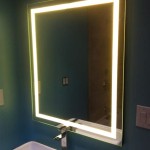How to Screen Mirror on a Roku TV Without WiFi
Screen mirroring, the process of displaying the screen of a smartphone, tablet, or computer onto a television, has become a popular method for sharing content and enhancing the viewing experience. While many modern devices rely on WiFi networks for this functionality, situations arise where a WiFi connection is unavailable or unstable. This article explores alternative methods for screen mirroring onto a Roku TV without the need for a WiFi network.
Roku TVs are recognized for their simplicity and extensive selection of streaming channels. The standard screen mirroring feature typically operates through Miracast, a wireless display standard that depends on a shared WiFi network between the source device and the Roku TV. The absence of WiFi connectivity necessitates the use of other technologies and methods to achieve screen mirroring. These alternatives leverage direct connections or create temporary ad-hoc networks to facilitate communication between devices. Understanding these methods allows users to maintain screen mirroring capabilities even when faced with WiFi limitations.
Utilizing a USB-to-HDMI Adapter
One of the most reliable methods for screen mirroring without WiFi involves establishing a direct physical connection between the source device and the Roku TV using a USB-to-HDMI adapter. This approach is particularly suitable for devices that offer USB-C or other USB variants capable of video output. The necessary adapter converts the USB signal into an HDMI signal, which can then be connected to the Roku TV. This method bypasses the need for wireless communication and therefore circumvents the WiFi requirement.
The first step is identifying the appropriate adapter for the source device. For example, many Android phones and tablets, as well as some laptops, utilize USB-C ports that support DisplayPort Alternate Mode (DP Alt Mode). This allows the USB-C port to directly output video signals via an adapter. For Apple devices with Lightning ports, a Lightning Digital AV Adapter is required. These adapters are readily available from various electronics retailers and online marketplaces. Ensure compatibility by verifying that the adapter specifically supports screen mirroring or video output for the intended device.
Upon acquiring the appropriate adapter, connect it to the source device's USB port. Next, connect an HDMI cable from the adapter to one of the HDMI ports on the Roku TV. Once the physical connections are established, power on the Roku TV and select the corresponding HDMI input using the Roku remote. The source device's screen should now be mirrored on the Roku TV. This method provides a stable and high-quality connection, making it ideal for watching videos, playing games, or delivering presentations.
It's important to note that some devices might require additional configuration to enable video output through the USB port. Check the device's settings or user manual for specific instructions. In some cases, a driver installation on the source device may be necessary, particularly when using a laptop or desktop computer. The manufacturer of the USB-to-HDMI adapter typically provides the appropriate drivers on their website or included documentation. While slightly more involved, this method offers a dependable solution for screen mirroring without WiFi, especially in environments where wireless interference is a concern.
Creating a Mobile Hotspot for a Localized Network
While the primary goal is to avoid using an existing WiFi network, another viable option involves creating a temporary, localized network using a mobile hotspot. Most smartphones and tablets offer the ability to create a mobile hotspot, which allows other devices to connect to the device's cellular data connection as if it were a WiFi network. This provides a controlled environment for screen mirroring without relying on an external WiFi network.
To set up a mobile hotspot, navigate to the settings menu of the smartphone or tablet. Look for options such as "Mobile Hotspot," "Personal Hotspot," or "Tethering & Portable Hotspot." Enable the hotspot feature and configure the network name (SSID) and password. Choose a strong password to ensure the security of the hotspot. Note that using a mobile hotspot will consume cellular data, so it is crucial to monitor data usage to avoid exceeding data limits or incurring additional charges.
Once the mobile hotspot is active, connect both the Roku TV and the device intended for screen mirroring to the newly created WiFi network. On the Roku TV, go to the settings menu and select "Network." Choose "Wireless" and select the mobile hotspot network from the list of available networks. Enter the password and connect to the hotspot. Similarly, connect the smartphone, tablet, or laptop to the same mobile hotspot network.
With both devices connected to the mobile hotspot, initiate the screen mirroring process as if connected to a standard WiFi network. On the source device, locate the screen mirroring or casting option. This might be found in the display settings, quick settings panel, or within specific applications like YouTube or Netflix. Select the Roku TV from the list of available devices. The screen of the source device should now be mirrored on the Roku TV. This method provides a wireless screen mirroring experience, albeit one that relies on cellular data and a locally generated network.
It is crucial to understand the potential limitations of this method. Cellular data speeds can vary significantly depending on location and network congestion. Slower data speeds may result in buffering or reduced image quality during screen mirroring. Additionally, excessive data usage can quickly deplete the available data allowance. Therefore, it is advisable to use this method sparingly and monitor data usage closely. Consider optimizing video quality settings to reduce data consumption while maintaining a satisfactory viewing experience.
Utilizing Miracast with a Direct Wireless Connection (On Supported Roku Models)
Some Roku TV models offer the capability to establish a direct wireless connection with compatible devices using Miracast, even without an existing WiFi network. This feature creates an ad-hoc wireless connection between the source device and the Roku TV, allowing for screen mirroring without the need for a traditional router or internet access. This method relies on the inherent capabilities of Miracast to form a peer-to-peer wireless connection.
First, verify whether the Roku TV model supports direct Miracast connections. Consult the Roku TV's user manual or specifications to confirm compatibility. If the Roku TV supports this feature, navigate to the settings menu and locate the "Screen Mirroring" or "Wireless Display" option. Ensure that screen mirroring is enabled and set to "Prompt" or "Always Allow." This setting allows the Roku TV to accept incoming Miracast connection requests.
On the source device, locate the screen mirroring or casting option. This option is often found in the display settings, quick settings panel, or notification shade. Look for options like "Cast," "Screen Mirroring," "Wireless Display," or "Miracast." Select this option to initiate a search for available wireless display devices. The Roku TV should appear in the list of available devices. Select the Roku TV to initiate the connection process.
The Roku TV might display a prompt asking for permission to allow the connection from the source device. Grant permission to establish the connection. Once the connection is established, the screen of the source device should be mirrored on the Roku TV. This method offers a direct wireless connection without the need for an intermediary WiFi network. It leverages the Miracast standard to create a point-to-point wireless link between the devices.
However, this method can be susceptible to interference from other wireless devices or obstacles. The range of the direct wireless connection is typically limited, so it is essential to keep the source device and Roku TV relatively close to each other. Additionally, the performance of the connection can vary depending on the capabilities of the source device and the Roku TV. Some older devices might experience lag or reduced image quality. Ensure that both devices are updated with the latest firmware and drivers to optimize performance. This method provides a valuable alternative for screen mirroring in situations where WiFi is unavailable, but its reliability can be influenced by environmental factors and device compatibility.
In conclusion, while the most common method for screen mirroring to a Roku TV relies on a WiFi network, several alternative approaches exist that allow users to mirror their screens even without access to a WiFi connection. These methods range from establishing direct physical connections using USB-to-HDMI adapters to creating temporary mobile hotspots or leveraging the direct Miracast capabilities of certain Roku TV models. The best method depends on the available resources, the capabilities of the source device and Roku TV, and the desired level of convenience and performance. By understanding these alternatives, users can maintain screen mirroring functionality in a variety of environments and situations.

How To Screen Mirror Roku Without Wifi

How To Mirror Your Iphone Roku With Or Without Wi Fi

How To Screen Mirror From Your Phone Tablet Or Computer Roku Streaming Device

Screen Mirror On Roku Without Wifi Ios Android

Screen Mirror On Roku Tv Without Wifi

Screen Mirror On Roku Without Wifi Ios Android

How To Screen Mirror From Your Phone Tablet Or Computer Roku Streaming Device

How To Screen Mirror Roku Tv Guide Troubleshooting

How To Screen Mirror From Your Phone Tablet Or Computer Roku Streaming Device

Screen Mirror On Roku Without Wifi Ios Android







